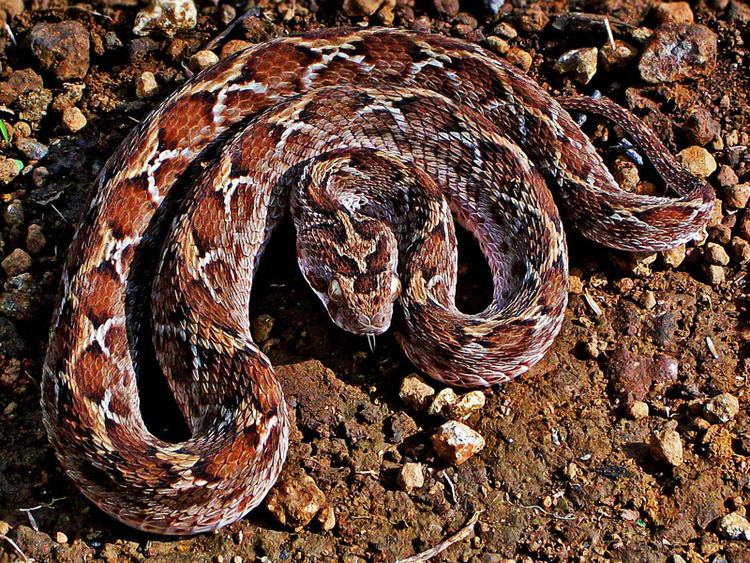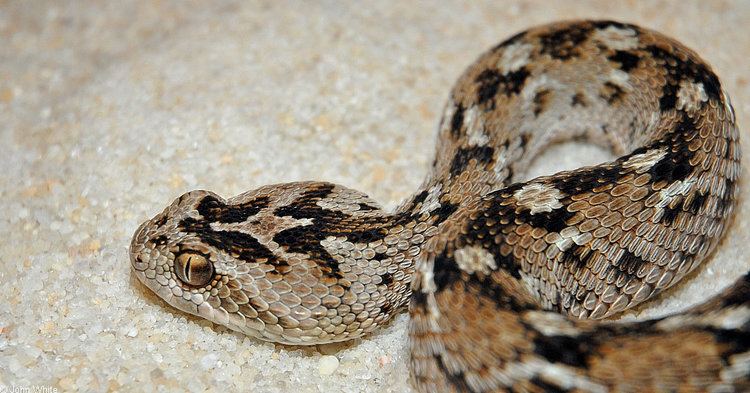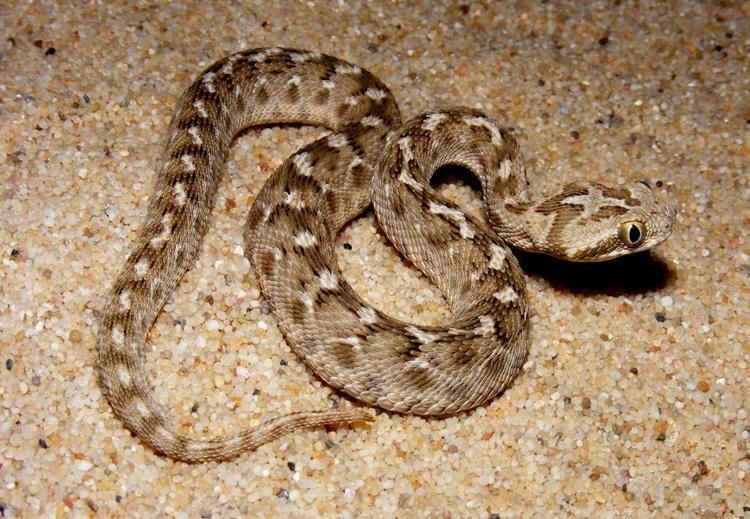Subphylum Vertebrata Suborder Serpentes Scientific name Echis | ||
 | ||
Lower classifications Echis carinatus, Echis coloratus, Echis ocellatus, Echis leucogaster, Echis megalocephalus | ||
Saw scaled viper echis carinatus
Echis (сommon names: saw-scaled vipers, carpet vipers) is a genus of venomous vipers found in the dry regions of Africa, the Middle East, Pakistan, India, and Sri Lanka. They have a characteristic threat display, rubbing sections of their body together to produce a "sizzling" warning sound. The name Echis is the Latin transliteration of the Greek word for "viper" (ἔχις). Their common name is "saw-scaled vipers" and they include some of the species responsible for causing the most snakebite cases and deaths in the world. Eight species are currently recognized.
Contents
- Saw scaled viper echis carinatus
- Echis tribute
- Description
- Geographic range
- Behaviour
- Diet
- Reproduction
- Venom
- Species
- Taxonomy
- References

Echis tribute
Description

Saw-scaled vipers are relatively small snakes, the largest species (E. leucogaster, E. pyramidum) staying slightly below 90 cm (35 in) in total length (body + tail), and the smallest (E. hughesi, E. jogeri) being around 30 cm (12 in) in total length.

The head is relatively small and is short, wide, pear-shaped and distinct from the neck. The snout is short and rounded, while the eyes are relatively large and the body is moderately slender and cylindrical. The dorsal scales are mostly keeled. However, the scales on the lower flanks stick out at a distinct 45° angle and have a central ridge, or keel, that is serrated (hence the common name). The tail is short and the subcaudals are single.

A saw scaled viper of the genus Echis may be responsible for biblical claims of a fiery flying serpent.
Geographic range

Species of this genus are found in Pakistan, India (in rocky regions of Maharashtra, Rajasthan, Uttar Pradesh, and Punjab) and Sri Lanka, parts of the Middle East, and Africa north of the equator.
Behaviour

All members of this genus have a distinctive threat display, which involves forming a series of parallel, C-shaped coils and rubbing them together to produce a sizzling sound, rather like water on a hot plate. The proper term for this is stridulation. As they become more agitated, this stridulating behavior becomes faster and louder. This display is thought to have evolved as a means of limiting water loss, such as might occur when hissing. However, some authors describe this display as being accompanied by loud hissing.
These snakes can be fierce and will strike from the position described above. When doing so, they may overbalance and end up moving towards their aggressor (an unusual behavior for snakes).
Diet
Little is known about the diets of some Echis species. For others, their diets are reported to be extremely varied, and may include items such as locusts, beetles, worms, slugs, spiders, scorpions, centipedes, solifugids, frogs, toads, reptiles (including other snakes), small mammals, and birds.
Reproduction
Most Echis species, such as those found in Africa, are oviparous, while others, such as those in India, are viviparous.
Venom
The venom of Echis species consists mostly of hemotoxins and cytotoxins. The genus is recognized as medically significant in many tropical rural areas. They are widespread and live in areas lacking modern medical facilities. Most victims are bitten after dark when these snakes are active.
Most of these species have venom that contains factors that can cause a consumption coagulopathy and defibrination, which may persist for days to weeks. This may result in bleeding anywhere in the body, including the possibility of an intracranial hemorrhage. The latter classically occurs a few days following the bite.
Venom toxicity varies among the different species, geographic locations, individual specimens, sexes, over the seasons, different milkings, and, of course, the method of injection (subcutaneous, intramuscular, or intravenous). Consequently, the LD50 values for Echis venoms differ significantly. In mice, the intravenous LD50 ranges from 2.3 mg/kg (U.S. Navy, 1991) to 24.1 mg/kg (Christensen, 1955) to 0.44-0.48 mg/kg (Cloudsley-Thompson, 1988). In humans, the lethal dose is estimated to be 3–5 mg/kg (Minton, 1967). Venom from females was more than twice as toxic on average than venom from males.
The amount of venom produced also varies. Reported yields include 20–35 mg of dried venom from specimens 41–56 cm in length, 6–48 mg (16 mg average) from Iranian specimens and 13–35 mg of dried venom from animals from various other localities. Yield varies seasonally, as well as between the sexes: the most venom is produced during the summer months and males produce more than females.
Species
*) Not including the nominate subspecies
T) Type species
Taxonomy
Some sources also mention several other species:
